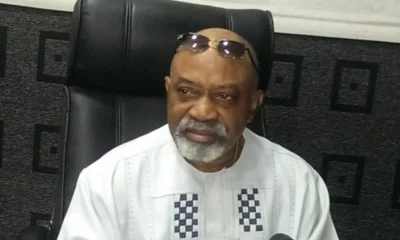Tech
NASA increases the chance of ‘city-destroying’ asteroid hitting Earth
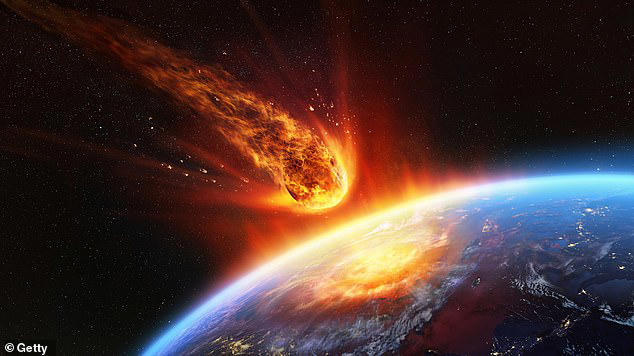
- READ MORE: Map reveals what will happen if the ‘city-destroying’ asteroid hits
The ‘city-destroying’ asteroid hurtling toward Earth is being carefully watched by hundreds of the world’s most powerful telescopes.
Now, NASA has quietly increased the chances that this deadly space rock will smash into the planet in 2032.
The space agency predicts that the asteroid 2024 YR4 has a one-in-38, or 2.6 per cent, chance of hitting.
Those are the same odds as having your number come up on a spin of a standard American roulette wheel.
When it was discovered in December last year, NASA estimated that the chances of 2024 YR4 hitting us were one in a thousand.
However, as more data has been gathered about its orbit, the impact probability has rapidly increased.
Currently, the odds of 2024 YR4 hitting Earth on December 12, 2032, are double what they were at the end of January less than three weeks ago.
With an estimated diameter of 54 metres (177ft), or a little taller than Nelson’s Column in Trafalgar Square, that collision has the potential to cause enormous amounts of damage.

NASA has quietly increased the chances that the city-destroying asteroid 2024 YR4 could hit Earth in 2032 once again (stock image)
The asteroid was discovered on December 27 by the NASA-funded Asteroid Terrestrial-impact Last Alert System (ATLAS) telescope in Chile.
Early calculations of its orbit quickly showed that there was a slim chance of the near-Earth object (NEO) making a close pass of the planet in the next decade.
However, as astronomers made more observations and arrived at a better estimation of the asteroid’s orbit, the probability of a collision continued to rise.
On January 27, 2024 YR4 truly set alarm bells ringing when it became the only large asteroid with an impact probability greater than one per cent.
This prompted NASA to award the asteroid a score of three on the Torino Scale, a standard measure for the danger of NEOs.
This rating is extremely rare since it can only be given to an object over 20 metres (65ft) in diameter with an impact probability greater than one per cent.
The Torino scale describes this threat as: ‘A close encounter, meriting attention by astronomers. Current calculations give a 1% or greater chance of collision capable of localized destruction.’
Were the asteroid to hit Earth, NASA estimates that the explosion would be equivalent to eight megatons of TNT.
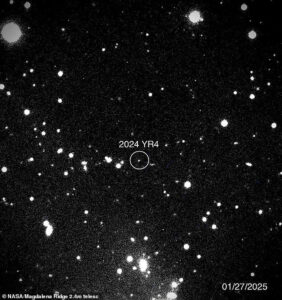
NASA now estimates that the 54 metre-wide (177ft) asteroid has a one-in-38 chance of hitting Earth. Those are the same odds as a specific number coming up on a standard American roulette wheel
That is more than 500 times the power of the atomic bomb dropped on Hiroshima during World War II.
The resulting blast would be similar to that caused by the Tunguska Asteroid, which flattened 830 square miles (2,150 square km) of Siberian forest in 1908 – an area more than double the size of New York.
Based on current estimates of the asteroid’s orbit, astronomers have calculated a ‘risk corridor’ of locations that could be hit if it were to collide with Earth.
This path stretches from northern South America, across sub-Saharan and North Africa, and into South Asia.
Worryingly, the risk corridor passes over eight of the world’s most populated cities, including Bogota in Colombia, Lagos in Nigeria, as well as Mumbai and Chennai in India.
Those cities alone have a combined population of over 110 million people, who could be in serious danger from an asteroid impact.
In the history of astronomy, only one other asteroid has ever been given a Torino Scale rating of three or higher – that being the 185-metre (600ft) 99942 Apophis.
Apophis, nicknamed the ‘God of Chaos’ asteroid, was briefly escalated to a four on the Torino Scale in late 2004 before rapidly dropping back towards zero.
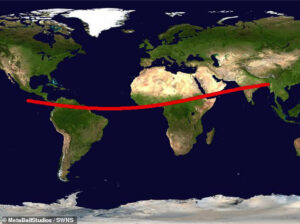
The estimated ‘risk corridor’ for the asteroid’s impact (red line) passes over eight of the world’s 100 most populated cities, with a combined population of 110 million people
Astronomers around the world are currently holding out hope that 2024 YR4 will soon follow a similar pattern.
Most NEOs have a higher impact probability right after they are detected with the risk dropping off as scientists gather more data about their orbits.
At first, as lots of new data comes in, the probability tends to sharply increase creating the impression of a rapidly growing risk.
However, NASA and the European Space Agency (ESA) currently predict that this should be followed by a drop in probability once the astronomers can be more certain about the asteroid’s orbital path.
NASA spokesperson Molly Wasser wrote in a blog post: ‘As more observations of the asteroid’s orbit are obtained, its impact probability will become better known.
‘It is possible that asteroid 2024 YR4 will be ruled out as an impact hazard, as has happened with many other objects that have previously appeared on NASA’s.’
She adds: ‘It is also possible its impact probability will continue to rise.’
Both NASA and ESA will continue to make observations of the asteroid until April at which point it will become too faint to observe until it returns around June 2028.
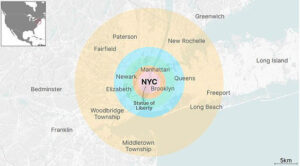
If the asteroid did hit Earth, the resulting blast could topple residential structures within a 8.5-mile radius (13.7 km) (shown as blue) and break windows everywhere within 24.6 miles (39.6km) (yellow)
In a rare emergency decision, ESA has also been granted access to the James Webb Space Telescope in March to better assess the risk posed by 2024 YR4.
The JWST will record the heat emitted by the asteroid using its infrared sensors which will give a more accurate estimate for its size.
Those measurements will be key to making a decision on whether action needs to be taken to divert the asteroid from its course.
If the decision is made to push the asteroid off its current course, the most likely option would be using a ‘kinetic impactor’ to push it aside by ramming a satellite into the asteroid as fast as possible.
In 2022, NASA’s DART mission showed that it was possible to significantly alter the trajectory of a large asteroid with a satellite collision.
However, with only eight years until the asteroid arrives, some scientists have cast doubt on the plan to deflect the killer asteroid.
In a post on X, Dr Robin George Andrews, a volcanologist and author based in London, points out that we ‘have less than eight years to potentially deal with it’.
‘You need 10 years or more to build, plan and execute an asteroid deflection mission,’ he said.
Tech
“I Lost $1.2 Million To Hackers On One Of My Apps. I Caught One Of The Hackers, And Instead Of Handing Him Over To The Police, I Employed Him To Work For Me.”- BLord

Anambra Born tech entrepreneur and businessman Linus Williams, popularly known as BLord, has shared an unusual story about how he handled a major cyberattack on one of his applications.
According to BLord, he lost $1.2 million to hackers who infiltrated one of his digital platforms. In the course of tracking the incident, he successfully identified one of the individuals involved in the breach.
Rather than handing the suspect over to security agencies, BLord said he made a strategic decision: he employed the hacker.
He explained that the hacker’s skills, though misapplied, were exceptional and could be redirected towards strengthening his company’s cybersecurity systems.
BLord noted that the decision was driven by a desire to turn a negative experience into an opportunity for growth and to better secure his business infrastructure.
Tech
MAN Honours Zobis Cable CEO, Ezeobi, at 37th AGM

The MD/CEO of John Zobis Group, Mr. John Ezeobi, has again been honoured with another major industry prize in recognition of his contributions to local sourcing, innovation and the growth of Nigeria’s manufacturing capacity.
The prestigious award, “Pillar of Industrial Enterprise and National Impact,” which was conferred on him by the Manufacturers Association of Nigeria (MAN) — Anambra, Ebonyi and Enugu Zone, was presented during the association’s 37th Annual General Meeting, Awards & Gala Night at the International Conference Centre, Enugu.
coming barely three weeks after Ezeobi was nominated as the winner of The Sun’s Industrialist of the Year Award 2025 by the Management of The Sun Newspaper, a run of recognition that has further highlighted his rising profile in the South-East manufacturing ecosystem.
The latest award, it was gathered, celebrates Ezeobi’s deliberate investment in backward integration, his push for local sourcing of raw materials and efforts to strengthen domestic value chains, which MAN described as essential to reducing import dependence and creating jobs across the region.
Chaired by Chief Obinna Iyiegbu (Obi Cubana), the well-attended occasion, themed “Exploring Opportunities for Backward Integration and Local Sourcing of Raw Materials for the Manufacturing Sector,” brought together regulators, policymakers, manufacturers and industry stakeholders and also featured presentations, panel sessions and cultural performances, among other highlights.
Speaking at the event, the Keynote Speaker and Director-General of the Raw Materials Research and Development Council (RMRDC), Prof. Nnanyelugo Ike-Muonso, said the economic benefits of exploring Opportunities for backward integration and local sourcing of raw materials for the Manufacturing sector cannot be overemphasized.
Prof. Ike-Muonso told delegates that Nigeria spent over ₦3.53 trillion importing raw materials in the first half of 2025 alone, warning that such dependence continues to weaken the nation’s economy. He further argued that the proposed 30% Value Addition Bill, which would require a minimum local value addition before export, would be transformational if signed into law.
He also outlined the bill’s potential to expand GDP, generate hundreds of thousands of jobs and save foreign exchange by keeping more of the country’s raw-material wealth in domestic supply chains, boost local manufacturing, and generally reposition Nigeria as a regional industrial hub.
On his own part, the Governor of Enugu State, Dr. Peter Mbah, endorsed the call for stronger industry-academia partnerships and urged financial institutions to make affordable credit available to manufacturers who adopt backward integration. The governor, who was represented by his Deputy, Barrister Ifeanyi Ossai, described the policy pathway as key to moving Nigeria from resource export dependence toward higher-value industrial output.
Reacting via his social handle shortly after receiving the award, the Zobis Cable Boss expressed gratitude for the honour, describing it as a strong motivation to do more in driving local production, reducing import dependence, and strengthening Nigeria’s industrial base.
Ezeobi, who received the plaque from pioneer Nollywood star and legal practitioner, Barr. Kenneth Okonkwo, attested that the AGM provided a critical platform for renewed commitment to backward integration as a pathway to sustainable industrial development.
“The event highlighted the critical importance of backward integration and local sourcing of raw materials as strategic levers for strengthening domestic production, reducing import dependency, and building resilient, self-sustaining industries. A meaningful platform for driving progress and collaboration across Nigeria’s manufacturing sector,” he partly wrote.
Also speaking, the Chairman of MAN for the Anambra-Ebonyi-Enugu zone, Dr. Adaora Chukwudozie, described local sourcing as the pragmatic route to lowering production costs and stabilizing supply chains for SMEs and larger manufacturers alike. She welcomed RMRDC’s roadmap and invited state governments to partner in establishing raw-material corridors and shared processing facilities that would bring inputs closer to factories.
The event, which had His Eminence, Eze Eberechukwu Orji, Eze Aro, as the Royal Father of the Day, was also graced by other notable dignitaries and stakeholders, which include Senator Osita Izunaso, Dr. Gideon Chidiebere Osi, Ichie Sunday Ezeobiora , Chairman, Sunchi Farms; Mr Linus Williams Ifejika, Chairman Blord Group; Otumba Francis Meshioye, National President, Manufacturers Association of Nigeria; Dr. Ifeanyi Okoye, Chairman, Juhel Pharmacy; Chief Dr. Dan Chukwudozie, Chairman,Dozzy Group; Dr. Chike Obidigbo,Chairman, Hardis and Dromedas; Anambra Commissioner for Trade and Industry,Mr. Christian Udechukwu.














Tech
GLOBACOM SEALS STRATEGIC CONNECTIVITY PARTNERSHIP TO DRIVE IMO STATE’S DIGITAL TRANSFORMATION AGENDA

By Prince Uwalaka Chimaroke
15-NOV-2025
Globacom, one of Nigeria’s leading digital solutions providers, has entered into a groundbreaking Internet connectivity agreement with the Imo State Government through the Ministry of Digital Economy and e-Governance—an ambitious step that signals the state’s commitment to becoming a fully digitized economy and a model Smart City in the South-East.
The agreement, hailed as the largest single fixed Internet connectivity initiative ever undertaken by Globacom’s Enterprise Business Group, underscores the company’s growing influence in deploying world-class telecommunications infrastructure across Nigeria. This milestone partnership positions the operator at the heart of Imo State’s fast-evolving digital future.
Through the deal, Globacom will deliver high-capacity, state-of-the-art Internet infrastructure to strategic government and institutional locations. These include the 15-building Smart City complex in Owerri, the Ministry of Digital Economy and e-Governance, and the Imo State University for Innovation, Science and Technology (formerly Imo State Polytechnic). The infrastructure rollout is expected to strengthen digital literacy, modernize public administration, and enhance access to digital services for residents.
A central component of the project is the integration of the Glo-1 submarine cable—Globacom’s privately owned, trans-Atlantic fibre optic system that links Nigeria directly to Europe. Known for its high bandwidth, ultra-low latency, and secure connectivity, the Glo-1 network will serve as the backbone for Imo State’s digital expansion.
With this partnership, Imo State aims to accelerate e-governance, improve the efficiency of public service delivery, attract technology-driven investments, and promote innovation across sectors including education, commerce, and security.
The collaboration demonstrates a shared vision between the State Government and Globacom: to empower citizens, institutions, and businesses through robust digital infrastructure that can sustain long-term economic growth.
-
Business1 year ago
US court acquits Air Peace boss, slams Mayfield $4000 fine
-

 Trending1 year ago
Trending1 year agoNYA demands release of ‘abducted’ Imo chairman, preaches good governance
-

 Politics1 year ago
Politics1 year agoMexico’s new president causes concern just weeks before the US elections
-

 Politics1 year ago
Politics1 year agoPutin invites 20 world leaders
-

 Politics1 year ago
Politics1 year agoRussia bans imports of agro-products from Kazakhstan after refusal to join BRICS
-
Entertainment1 year ago
Bobrisky falls ill in police custody, rushed to hospital
-
Entertainment1 year ago
Bobrisky transferred from Immigration to FCID, spends night behind bars
-
Education1 year ago
GOVERNOR FUBARA APPOINTS COUNCIL MEMBERS FOR KEN SARO-WIWA POLYTECHNIC BORI











